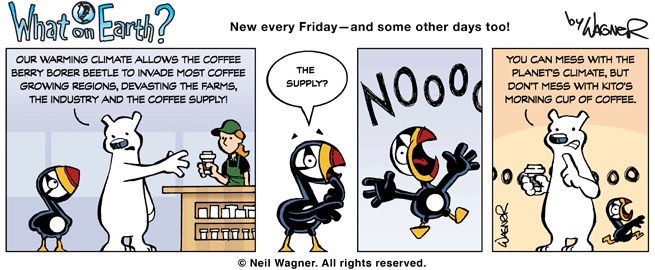Injecting humor into climate change: Interview with cartoonist Neil Wagner
 Many science communicators suggest that the key to effectively translating climate change research is to keep the message concise, accurate and interesting, all in one tight package. Perhaps the most streamlined of platforms to communicate this science is a comic strip in which the cartoonist has just a few panels to neatly and accurately convey the findings, the alternative viewpoint and the gravity of the issue at hand. Oh, and it should be funny too.
Many science communicators suggest that the key to effectively translating climate change research is to keep the message concise, accurate and interesting, all in one tight package. Perhaps the most streamlined of platforms to communicate this science is a comic strip in which the cartoonist has just a few panels to neatly and accurately convey the findings, the alternative viewpoint and the gravity of the issue at hand. Oh, and it should be funny too.
That is a tall order for even the best of communicators, but if it is pulled off, it is arguably the most dynamic and effective platform for engaging people in environmental issues. Take the above cartoon as an example: Neil Wagner, illustrator and writer of the blog and comic strip “What On Earth?” on NPR’s Science Friday program, uses humor to tackle the issue of global climate change and other environmental challenges, such as the effect of invasive species on the coffee industry.
Most would agree that emotion and beliefs play a large part in people’s opinions and understanding of climate change. In such an instance, readers might be less likely to consider a multiple page document discussing the details of a study, for example. And the more the public is surrounded with information on a topic, the less receptive they will be to hear more about it. Comic strips, on the other hand, are short but more likely to appeal to a reader’s emotions.
In an interview for EcoTone, Wagner explains the role of humor in engaging readers “I always want the artwork to be very entertaining….and to have the jokes, in their own right, sit alone and entertain people. Because I think that’s the draw, that’s the idea behind it—is, rather than come across as dry or preachy, I want people to really just enjoy it. Just for the sake of it being in a humorous comic strip. And then as they’re reading it…there is legitimate information in there.”
It should also be noted that, historically, political cartoons served a similar purpose; although political cartoons might fall into the category of humor at the expense of an agenda or opposing political group. Tom Toles, Pulitzer Prize-winning political cartoonist for The Washington Post has a satirical, no-holds-barred approach to addressing political issues. As might happen when using humor to make light of a heated, controversial issue, Tom Toles’ cartoons have kicked up negative emotions as well.
So how do you avoid alienating readers with opposing viewpoints when communicating a complex issue ? Wagner uses the two character format to include both sides of the issue. Bebbo, the polar bear, discusses the latest research on environmental issues while Kito, the puffin, remains skeptical of the issues. That is, an argument is more complete when the opposing side of the issue is addressed alongside the main point.
“Stay engaged with the public in a down-to-earth way, and focus on the fundamentals,” Wagner recommends to scientists. “Many people don’t have a strong grasp of the basics, and that’s certainly going to hinder their willingness to accept the gravity of anthropogenic climate change. For example, I’ve talked to plenty of people who hear ‘greenhouse effect’ and think it’s some negative man-made phenomenon invented by environmentalists. We need people to understand that the greenhouse effect is natural and necessary for our survival. I think keeping an open and friendly dialogue with the public using ‘user-friendly’ terms will be an aid to getting more people to recognize the gravity of the situation.”
Comic Strip: Copyright Neil Wagner